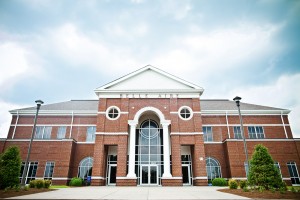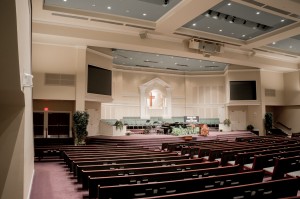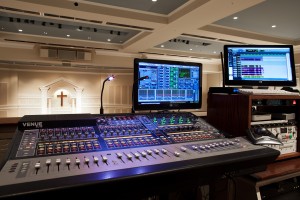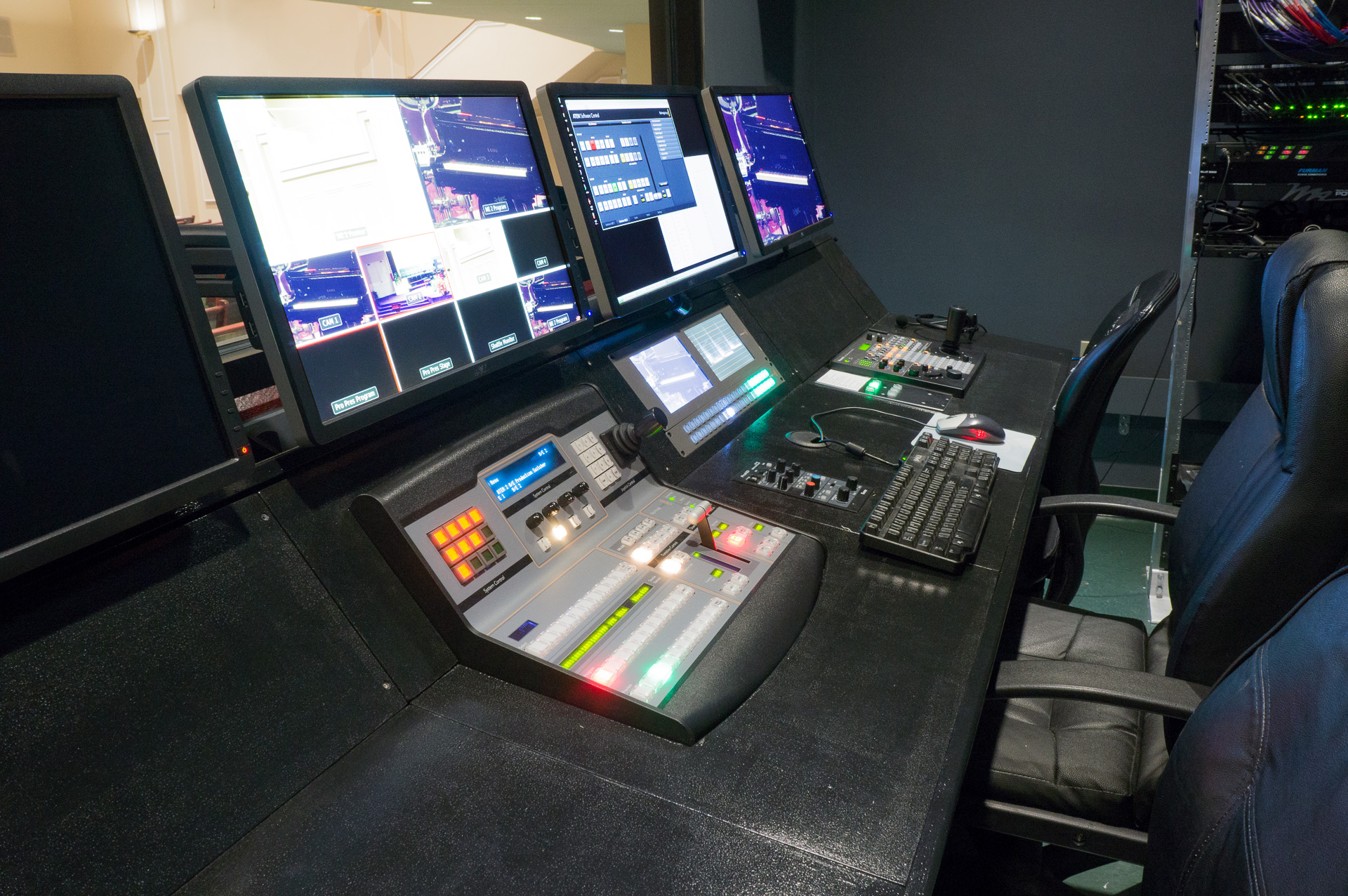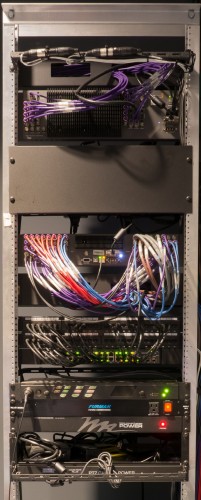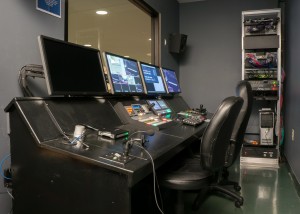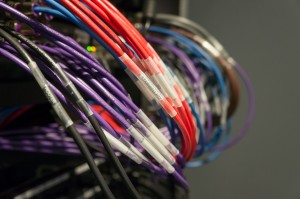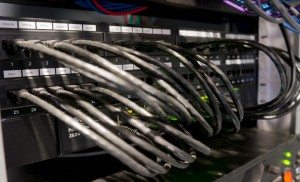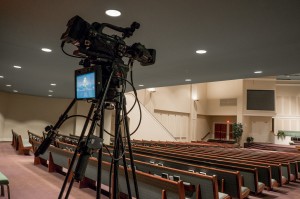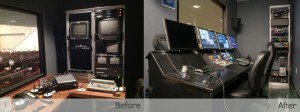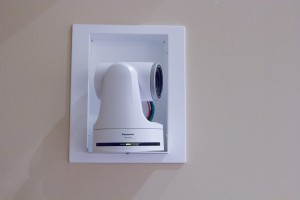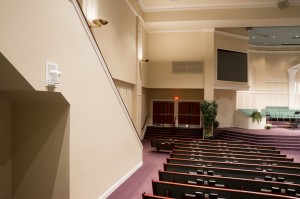In Their Own Words:
“I was completely blown away by the preparation and dedication to get it done right.”
Jason Taylor
Belle Aire Baptist Church
Background:
After outgrowing their building just across from MTSU’s campus (running 5 services each weekend), Belle Aire Baptist moved into their current facility on North Rutherford Blvd in Murfreesboro, TN in 2001. The church was blessed with an abundance of gifted musicians (so much so that their worship services feature a volunteer orchestra once a month), but getting good sound seemed like an illusive goal. In large part, this was because the church had been sold a sound system that consisted mostly of heavily used, obsolete equipment. Though installed in 2001, the speaker enclosures were copies of a popular manufacturer’s design from 1983. The main center array missed the front 2/3 of the room entirely, as only a small amount of down tilt was applied. The speaker drivers were highly fatigued so that even in the areas that were receiving sufficient coverage, the sound was muddy and lacked high frequency detail. As a way of mitigating the coverage issues, the vendor had provided 4 “front fill” speakers along the front of the stage, though these were only able to fill a portion of the area missed by the main array. Additionally, the pastor complained about their cluttered appearance. The mixing console had bounced around in a road case for a number of years prior to landing at the church’s mix position, so auxiliary buses dropped in and out at inopportune times and VCA assignments frequently went haywire.
The original lighting cove was at too steep of an angle relative to the stage which caused harsh shadows, especially under the eyelids of the person standing at the pulpit. This was particularly visible on the camera shot, as the second-hand cameras had very limited dynamic range. The excessive contrast of the video image was compounded by severe hot spotting in the sub-par rear projection surfaces when being used for image magnification.
The video system had been pieced together over time with used equipment due to very tight budget constraints, and different segments of the system operated at different video formats. Multiple analog conversions yielded degraded, pixelated images on all of the displays, and because there wasn’t a single standard, signal routing was highly inflexible.
Project Goals:
The new sound system needed to be visually unobtrusive but provide plenty of full-bandwidth coverage for the entire sanctuary, without the front fills. The new console needed to sound great, provide robust recall capabilities, and be capable of facilitating multitrack audio recording.
The video system would require a complete overhaul. The church wanted to be able to capture broadcast-quality video of services and special events, and they also wanted to be able to do quality image magnification, including lower third graphics.
The church had sufficient dimming capabilities and lighting fixture count, but a new lighting cove would be required to achieve the proper angles.
Solution:
Upgrades were handled in two phases – first audio; then video. The church’s lighting contractor acted on Essential Audio’s recommendation to add a second lighting cove in the correct location.
The large well-worn analog mixing console that had been so laden with issues was replaced with an Avid SC48, and presets for various kinds of events were established. The old loudspeakers were removed. The scrim that covered the center speaker cluster was also removed because there was an insufficient amount of room inside it to properly orient the downfill speaker that would be critical to achieving good coverage for the front rows. The speakers were painted to match the color of the proscenium wall to minimize the visual impact of this change. The new center speaker cluster is comprised of a Danley Sound Labs SH96 full range loudspeaker, with a TH115 subwoofer on each side. The cluster is affixed to a custom rigging frame that allowed for precise aiming of the loudspeakers. Because high SPL’s were not required, the existing CX series QSC amplifiers from the previous installation were re-used.
The video system was completely overhauled. Because the church wanted to be able to capture great camera shots of the various events without the distraction of studio camera operators all throughout the room, they opted for robotic cameras for all but the main camera. Panasonic AW-HE120 cameras were chosen for their image quality, focal range, dynamic range, and exceptionally smooth motion. Five Vaddio camera mounts were installed and wired around the sanctuary – on the side wall, rear wall, a rear pillar, and on each side of the stage, allowing the 3 robotic cameras to be moved. The data, video, and power from each position lands on a patch panel so that the system can be reconfigured based on the positions desired for any given program.
All of the VGA, S-video, and composite video equipment was removed and replaced with a full SDI system. All video inputs are either natively HD-SDI or are converted to SDI at the source. Likewise, output signals remain SDI until they reach their destination. A 40×40 SDI matrix and a 2 M/E switcher were installed. All signals pass through the matrix so that any source can be routed to any display. The two discrete switcher outputs allow for the main screens in the sanctuary and the record feed to be tied together or to operate independently.
A new custom modular desk was installed in the video switching suite which houses a hardware switcher control panel, a paint box for the JVC Camera, and the Panasonic Robotic Camera Controller. The desk can be reconfigured, should the church ever want to add a second robotic controller. The desk is laid out so that the production workload can be split up between two camera operators, a shader, and a switcher operator/director, or the roles can be adapted to a smaller crew if necessary.
Two computers reside at the presentation graphics control position within front of house – an iMac running Pro Presenter, and a PC that runs Blackmagic Design’s ATEM control software. A third LCD monitor displays multiview information. A Blackmagic Design Ultrastudio, working with a specialized plugin within Pro Presenter provides two separate SDI signals with key and fill layers for bullet-proof lower third graphics. The Pro Presenter operator controls source selection and keying on the main screens and rear screens via the software.
In the months preceding the camera system overhaul, the church had installed (40) 46″ LCD displays (one in each classroom, each with a local DVD player for use with their Sunday School Curriculum. The church desired to use these displays for digital signage as well. Essential Audio installed a QAM HDTV encoder and CATV cabling infrastructure that takes the program content from the sanctuary and encodes it on an HDTV channel which appears at each of the 40 televisions. Source selection and power for the all of the TV’s throughout the campus are controlled via a custom web interface. This is accomplished via an IR distribution system installed along the CATV lines.
Project Type
- Design-Build
- Phased AV Retrofit
Scope
- Audio – Sound Reinforcement
- Video – HD Displays
- Broadcast & Robotic Cameras
- SDI Switching & Infrastructure
- Campus-Wide HD Distribution
- Custom Rigging
Technology
Audio System
- Danley Sound Labs Synergy Horn Loudspeakers
- Danley Sound Labs Tapped Horn Subwoofers
- Biamp Nexia SP
- Avid SC48
- MacMini with ProTools
Video System
- Blackmagic Design 2M/E Switcher
- Blackmagic Design Compact VideoHub
- SDI Signal Distribution
- JVC Pro GYHM790
- Panasonic AWHE120
- Internal Digital CATV Distribution
- Infrared Control of 40+ LCD screens
Lighting
- Consultation



